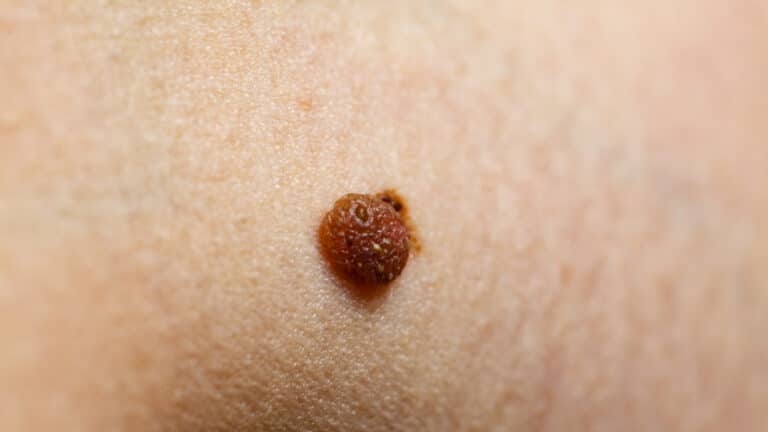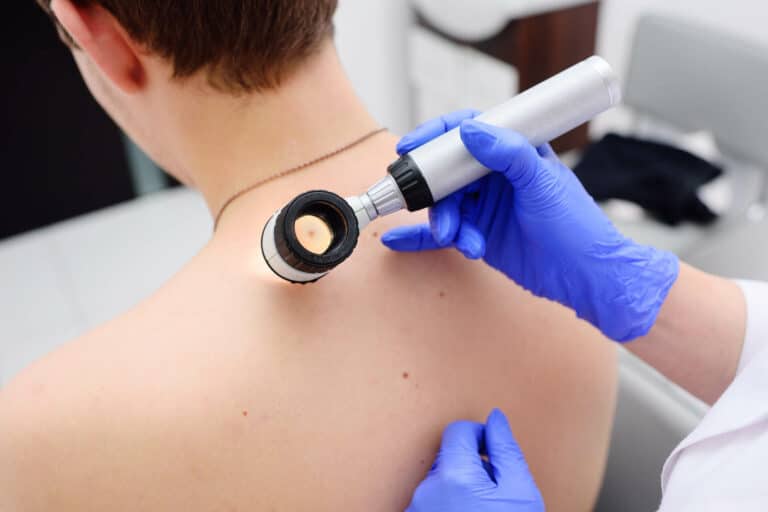What Are Moles?
Moles are common skin growths that are most often round, smaller in size than a pencil eraser, and are brown, pink, or flesh-colored. They are more common in lighter-skin individuals and often develop after sun exposure. Moles commonly first appear in childhood. They grow as the child grows and may become either lighter or darker over time. Some people are born with moles called congenital nevi. These can range in size from a few millimeters to several inches in diameter. Large congenital nevi should be monitored by your dermatologist because some of these are at increased risk of turning into a skin cancer.
Moles are usually considered benign and do not require treatment. If a mole develops asymmetry, irregular borders, multiple colors, grows quickly or becomes symptomatic (bleeds, itches, etc.), it may be an atypical mole (dysplastic nevus) or represent a skin cancer called a melanoma. It is important that you report any such changes to your dermatologist who may recommend a skin biopsy to establish a definitive diagnosis.
Normal, non-medically concerning moles can also be removed for cosmetic reasons. There are multiple methods for doing this, but all result in some form of scar. If you’re interested in having a mole removed, we will discuss the best options for doing so and help you make the best decision for you.
Dr. Moy leads a team of total pros and uses the latest technology. They don’t think treatment; they think solutions. Big difference.
John A. | Yelp
Related Posts
Mole removal is a common procedure that removes unwanted or suspicious moles. While it is typically a simple and safe outpatient procedure, proper aftercare is crucial for optimal healing and minimizing the risk of complications. Keep reading to learn more about how to properly care for your skin after mole removal! What to Expect After…
Do you have moles? They are extremely common, so having them is not unusual. Although most moles are harmless, some may become cancerous. For this reason, it’s crucial to keep an eye out for any changes. If you notice a new mole or one that has started to change, you need to see your dermatologist…
Skin cancer is the most common cancer in the U.S. One in every five Americans will get skin cancer in their lifetime. While melanoma is the least common type of skin cancer, it’s the most dangerous. If caught and treated early, melanoma is almost always curable. Keep reading to learn more about melanoma and the…
Skin cancer sounds straightforward: it’s an abnormal growth of cells. According to the Skin Cancer Foundation: 1 in 5 Americans will develop skin cancer by the age of 70. More than 2 people die of skin cancer in the U.S. every hour. Even though the definition is simple, knowing what “abnormal growth” looks like is anything but straightforward….
Acrochordons. Now that’s a word we rarely see, and most of us don’t know how to pronounce. Your dermatologist does, though. That’s because acrochordons, soft fibromas, or fibroepithelial polyps, are small, benign skin growths. We know them as skin tags. What are skin tags? Skin tags are what they sound like: little “tags” (like the…
Let’s be blunt about the bad news: nearly 20 Americans die from melanoma every day. It can appear without warning. It spreads to lymph nodes and internal organs. It can show up anywhere on the body – even the scalp, eyelids, and under fingernails. “Any kind of cancer is scary, but the good news for…












